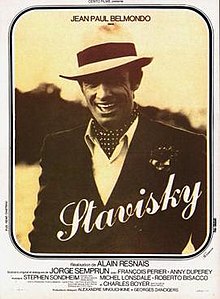Stavisky
| Stavisky... | |
|---|---|

French film poster
|
|
| Directed by | Alain Resnais |
| Produced by | Cérito-Films, Ariane Films (Paris), Euro-International (Rome) Director of production: Alain Belmondo |
| Written by | Jorge Semprún |
| Starring |
Jean-Paul Belmondo Anny Duperey |
| Music by | Stephen Sondheim |
| Cinematography | Sacha Vierny |
|
Release date
|
1974 |
|
Running time
|
120 min. |
| Country | France / Italy |
| Language | French |
| Box office | $7.6 million |
Stavisky... is a 1974 French film drama based on the life of the financier and embezzler Alexandre Stavisky and the circumstances leading to his mysterious death in 1934. This gave rise to a political scandal known as the Stavisky Affair, which led to fatal riots in Paris, the resignation of two prime ministers and a change of government. The film was directed by Alain Resnais and featured Jean-Paul Belmondo as Stavisky and Anny Duperey as his wife, Arlette. Stephen Sondheim wrote the film's musical score.
The core narrative of the film portrays the last months in the life of Serge Alexandre (Stavisky), from late 1933 to January 1934. We see glimpses of his operations as a "financial consultant", setting up a mysterious company to deal in international bonds, his 'laundering' of stolen jewellery, and his juggling of funds to stave off the discovery of fraudulent bonds that he has sold through the Crédit Municipal in Bayonne (municipal pawnbrokers); we see his activity as a theatre impresario in Paris, his casino gambling, his purchase of influence among the press, the police, and politicians, and always his extravagant lifestyle and desire to impress; we see his devotion to his glamorous wife Arlette, his exploitation of her beauty to lure funds from a Spanish revolutionary fascist, his contradictory accounts to his friends of events in his own past, and gleams of political idealism - which may yet be just expedients to create further webs of deception.
Interposed in the narrative are moments of flashback (to his teenage awakening to a hedonistic life, to his arrest as the petty crook Stavisky in 1926, and to his father's suicide after this family dishonour) and flash-forwards (to his funeral, and to the parliamentary enquiry into the Stavisky affair at which his friends and associates testify with varying degrees of honesty).
Also punctuating the main story are scenes depicting the arrival of Trotsky in France to seek political asylum, and his sojourn in various country houses and hotels, receiving visits from left-wing activists. These scenes appear to have no link with the main narrative (apart from two minor characters: the young German-Jewish actress who moves between both stories, and the police-inspector who monitors Trotsky's movements and then also investigates Alexandre), until the end of the film when, in the wake of Stavisky's fall and exposure as a Ukrainian immigrant, a Jew, and a confidant of members of the left-of-centre government, Trotsky's presence is deemed undesirable and he is expelled from the country, while a new 'government of national unity' is formed.
...
Wikipedia
